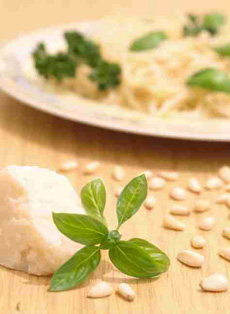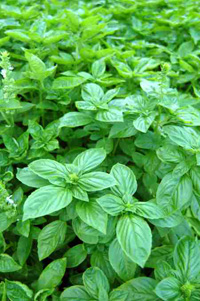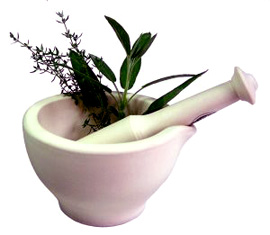

It all starts with basil, parmesan, pine nuts and olive oil.
|
ALISSA DICKER SCHRIEBER is a freelance writer and cooking teacher who resides in New York City.
|
|
January 2007
Updated March 2009
|
 |
The Best Pesto Sauce
Page 2: The History Of Pesto
This is Page 2 of a 10-page review. Click on the black links below to visit other pages.
The History of Pesto
The rocky, mineral-rich seaside terrain of Liguria’s fishing villages and mountain towns is well-suited for growing exceptional produce. This wealth of vegetation has greatly influenced the area’s cuisine, making the Ligurian diet one of the healthiest in Italy. Whereas in regions like Emilia-Romana, cheeses, meats and butter figure prominently in local dishes, they are used only sparingly in Liguria. Instead, meals center on herbs, vegetables, fruits, nuts, fish, olive oils, breads and pasta. Garlic, which is an uncommon ingredient in Northern Italian cuisine, makes many appearances on the Ligurian table. This healthful diet could explain why Ligurians  have some of the longest life expectancies in the world. have some of the longest life expectancies in the world.
Basil is perhaps the most famous of the region’s flora. Ocimum basilicum flourishes throughout Liguria’s terrain, where its small, round, pale green leaves develop a uniquely sweet, mild flavor and alluring fragrance. When visitors to Liguria purchase the seeds to its spectacular basil, they are often disappointed when theirs grows minty and bitter back at home. Genovese basil, it seems, has provenance, or terroir, like Champagne—the place it grows influences how it tastes. Likewise, the area’s olive oil is uniquely delicate. It’s made from Taggiasca olives, which grow largely in San Remo’s Valle Argentina. It is buttery, with a fruity minerality—not peppery or spicy like Tuscan or Spanish oils.
The abundance of exquisite basil and the presence of other quality ingredients has helped Pesto alla Genovese—an amalgam of basil, salt, garlic, pine nuts (or walnuts),  Parmigiano-Reggiano and/or Pecorino (Romano or Sardo) and extra virgin olive oil—become a cornerstone of the area’s cuisine. The sauce gets its name from the word pestle, as in mortar and pestle, the traditional device used to make pesto. The ingredients are ground in the mortar, ideally a marble bowl with a coarse interior, by pressing and pounding with a pestle, a stick with a rounded base for mashing. A pestle is best made of wood, which generates little heat as it rubs against the stone, so it won’t cook the fragile sauce. Parmigiano-Reggiano and/or Pecorino (Romano or Sardo) and extra virgin olive oil—become a cornerstone of the area’s cuisine. The sauce gets its name from the word pestle, as in mortar and pestle, the traditional device used to make pesto. The ingredients are ground in the mortar, ideally a marble bowl with a coarse interior, by pressing and pounding with a pestle, a stick with a rounded base for mashing. A pestle is best made of wood, which generates little heat as it rubs against the stone, so it won’t cook the fragile sauce.
In Recipes From Paradise, the definitive text on the cuisine of the region, Fred Plotkin includes more than a dozen pesto recipes, all of which call for basil, extra virgin olive oil, sea salt and, with the exception of only a few recipes, garlic. Ingredients are always similar, but they’re called for in various proportions, making some sauces stronger or sweeter than others. Some use a combination of Parmesan and Pecorino cheeses; others use only one. Some add butter to the pesto for added creaminess. Ligurian cooks have also been known to occasionally incorporate cooked potato into the sauce. At times, they combine pesto with tomatoes, creating what Plotkin calls Pesto Corto, or add a light, fresh cheese, like ricotta or prescineua, a cultured cheese similar to yogurt or crème fraîche.
Traditional preparations with pesto include trenette and triofe alla Genovese. Trenette, flat ribbon pasta almost identical to linguine with a surface the sauce can cling to, or triofe, dumpling-like, rolled, worm-shaped pasta with crevices for pesto to fill, are boiled along with small pieces of potato. They cook in about the same amount of time (using dry pasta), and when they’re almost done, string beans are added to the boiling liquid. The three ingredients are then tossed with pesto, adding some starchy cooking water to help it coat.
A dollop of pesto, made without any nuts, will often be added to minestrone soup (on the neighboring French Riviera, pistou is the name of a pesto-like sauce and the soup it accompanies). Pesto can also be found in lasagna, on gnocchi, and atop cooked meats, fish and vegetables.
Continue To Page 3: The Best Pesto Sauces ~ Sauces ‘n Love and Scarpetta
Go To The Article Index Above
Lifestyle Direct, Inc. All rights reserved. Images are the copyright of their individual owners.

|





 have some of the longest life expectancies in the world.
have some of the longest life expectancies in the world. Parmigiano-Reggiano and/or Pecorino (Romano or Sardo) and extra virgin olive oil—become a cornerstone of the area’s cuisine. The sauce gets its name from the word pestle, as in mortar and pestle, the traditional device used to make pesto. The ingredients are ground in the mortar, ideally a marble bowl with a coarse interior, by pressing and pounding with a pestle, a stick with a rounded base for mashing. A pestle is best made of wood, which generates little heat as it rubs against the stone, so it won’t cook the fragile sauce.
Parmigiano-Reggiano and/or Pecorino (Romano or Sardo) and extra virgin olive oil—become a cornerstone of the area’s cuisine. The sauce gets its name from the word pestle, as in mortar and pestle, the traditional device used to make pesto. The ingredients are ground in the mortar, ideally a marble bowl with a coarse interior, by pressing and pounding with a pestle, a stick with a rounded base for mashing. A pestle is best made of wood, which generates little heat as it rubs against the stone, so it won’t cook the fragile sauce.